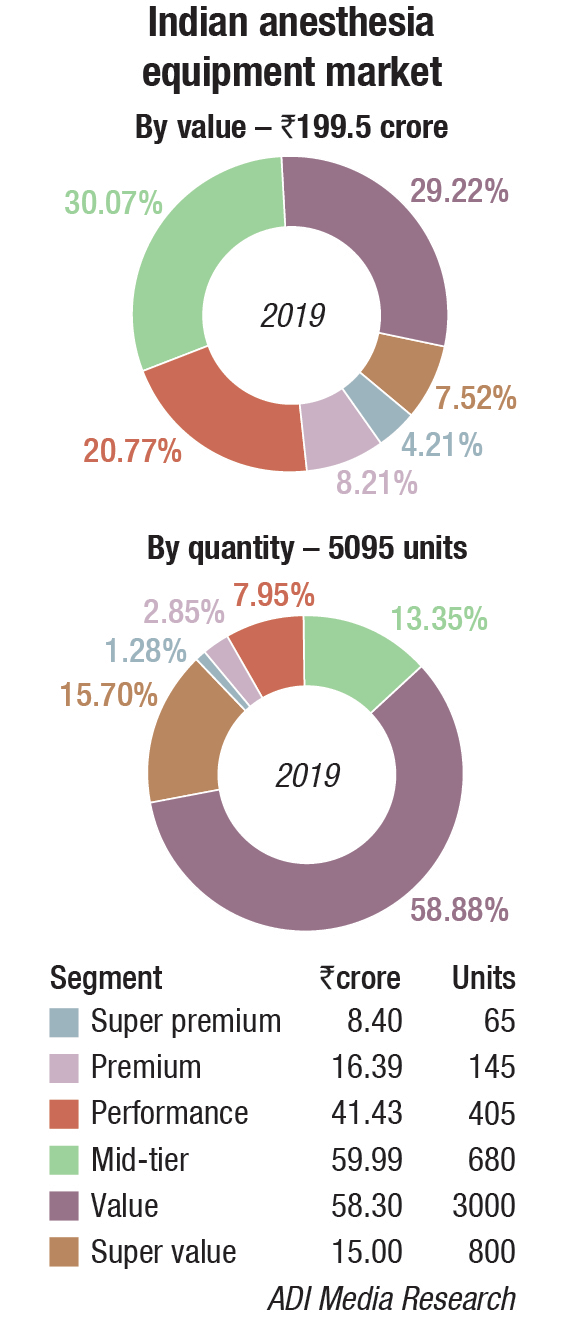Anesthesia Equipment
Anesthesia equipment majorly hit by the pandemic
2020 could well have been the year when the anesthesia segment would have taken baby steps toward automation. The pandemic, of course had other plans for this segment.
 Almost every facet of our society is becoming, for better or worse, progressively more technology-dependent. Technological advancement has made autonomous systems, robots, an integral part of our life in several fields, including medicine.
Almost every facet of our society is becoming, for better or worse, progressively more technology-dependent. Technological advancement has made autonomous systems, robots, an integral part of our life in several fields, including medicine.
The application of robots in anesthesia could be classified into 3 types of robots. The first ones are pharmacological robots. These are based on closed-loop systems that allow better-individualized anesthetic drug titration for optimal homeostasis during general anesthesia and sedation. Recent evidence also demonstrates that autonomous systems could control hemody-namic parameters proficiently outperforming manual control in the operating room.
The second type of robots are mechanical. They enable automated motorized reproduction of tasks requiring high manual dexterity level. Such robots have been advocated to be more accurate than humans and, thus, could be safer for the patient.
The third type are cognitive robots also known as decision support system. This type of robot is able to recognize crucial clinical situation that requires human intervention. When these events occur, the system notifies the attending clinician, describes relevant related clinical observations, proposes pertinent therapeutic options and, when allowed by the attending clinician, may even administer treatment. It seems that cognitive robots could increase patients’ safety.
Robots in anesthesia offer not only the possibility to free the attending clinicians from repetitive tasks but can also reduce mental workload allowing them to focus on tasks that require human intelligence such as analytical and clinical approach, lifesaving decision-making capacity, and interpersonal interaction.
Nevertheless, further studies have yet to be done to test the combination of these 3 types of robots to maintain simultaneously the homeostasis of multiple biological variables and to test the safety of such combination on a large-scale population.
The integration of robots into clinical practice aims at assisting the clinician. The goal is to increase treatment accuracy, improve patient safety, and reduce workload.
 Over six decades, new generation of anesthesia machines, invasive and non-invasive blood pressure monitors, cardioscopes, pulse oximeters, capnographs, temperature monitors, anesthesia depth monitors, neuromuscular transmission monitors, blood gas and biochemistry have been launched to make anesthesia safer. This is a giant leap from when Edmond Gaskin Boyle introduced anesthesia apparatus dispensing oxygen, nitrous oxide, cyclopropane, carbon dioxide, two plenum glass bottle vaporizers delivering diethyl ether and trichlorethylene.
Over six decades, new generation of anesthesia machines, invasive and non-invasive blood pressure monitors, cardioscopes, pulse oximeters, capnographs, temperature monitors, anesthesia depth monitors, neuromuscular transmission monitors, blood gas and biochemistry have been launched to make anesthesia safer. This is a giant leap from when Edmond Gaskin Boyle introduced anesthesia apparatus dispensing oxygen, nitrous oxide, cyclopropane, carbon dioxide, two plenum glass bottle vaporizers delivering diethyl ether and trichlorethylene.
Dr D. Dasgupta
Director of Anaesthesia, Jaslok Hospital & Research Centre
The final objective is to allow the anesthesiologist to focus on tasks requiring human intelligence. Autonomous systems for general anesthesia, sedation, and manual tasks in combination with cognitive help are not inferior to the performance of anesthesiologists and may eventually allow superior performance. Robots in anesthesia are made to assist anesthesiologists providing a technological mental and physical augmentation to the clinician allowing a smart distribution of the workload. The goal of automation is not to replace a qualified care provider normally required for a particular task or intervention, but rather to assist a standard provider in application of an intervention ensuring that the highest quality of care is being used consistently and effectively for all patients.
Future studies will determine whether they could have a clinical impact on outcomes compared to anesthesia conducted without the help of autonomous systems.
Recent developments
Anesthesiologists have developed standards for continuous real-time monitoring of hemodynamics, oxygenation, ventilation, neurological status, urine output, core temperature, the degree of neuromuscular blockade, as well as other items, all of which have also contributed significantly to patient safety.
Recent applications of artificial intelligence (AI) systems have instilled fear and apprehension among medical specialists. There is speculation that AI may significantly reduce the demand for anesthesiologists. Physicians have expressed skepticism regarding the capability of a machine to reproduce the complex decision-making capacity of a trained and experienced professional. However, some anesthesiologists have identified potential benefits of AI and have embraced the entry of these systems into their workflow.
Artificial intelligence is the ability of a computer to respond to problems in a human-like fashion. At its core, AI is characterized by two main features: autonomy and adaptivity. An AI method must be autonomous and able to perform tasks without continuous guidance by the user.
The idea that a computer could theoretically make better clinical decisions that result in improved patient outcomes is scary. Yet, this should not come as a surprise to most. AI, much like computers and calculators, are machines which were designed to excel at computing. The question becomes, after years of rigorous medical training, could we be replaced by an expensive operating system? The simple answer is no — at least not anesthesiologists. Currently, AI systems can be trained to be methodical, but they lack the intuition required to apply these methods in the context of a sentient patient and the dexterity to perform complex procedures on dynamic patients. For example, anesthesiologists commonly manage acute situations in which a patient cannot provide consent, and a physician must proceed with a course of action which a reasonable person would want. Intuition is not easily replicated by a machine as it does not utilize conscious reasoning, but rather relies on subconscious processing of feelings — something a computer cannot decipher.”
AI is an expanding field that will likely change the way we work and interact with technology as a society. In health systems that are burdened by being overcapacity, machines that can improve efficiency and accuracy should be embraced. Machine learning applications in anesthesia are clearly not just a fad. As health systems continuously evolve, determining how to integrate AI into the perioperative care of patients is yet to be fully understood.
COVID-19
Understanding of COVID-19 is evolving rapidly. Goals for infection control during anesthesia include prevention of transmission of infection to care providers, and prevention of contamination of the anesthesia machines and other anesthesia equipment. Infection control measures are the same for patients with suspected or confirmed COVID-19. In any case, elective procedures are still being performed selectively.
And, 2020 can be considered a write-off for this segment, both in terms of adapting to technology advancement and demand.











